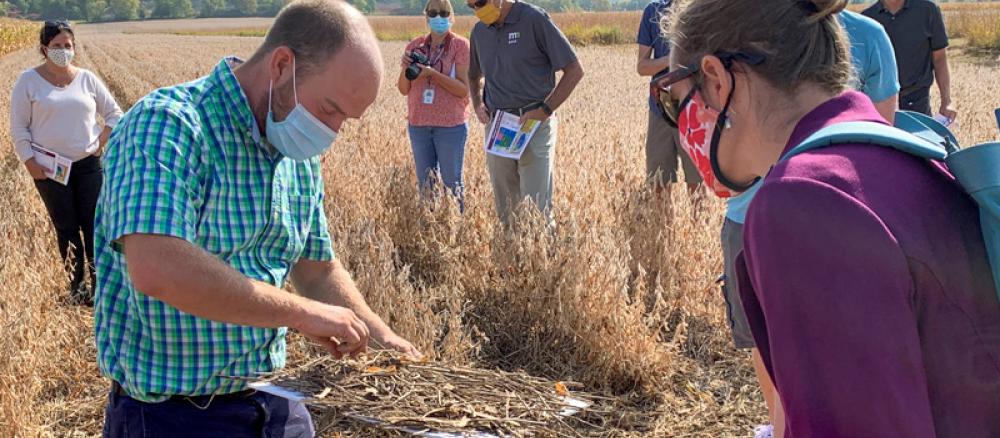In the middle of an Olmsted County cornfield during Climate Week 2020, Minnesota Pollution Control Agency (MPCA) Commissioner Laura Bishop and other state leaders charged with protecting Minnesota’s treasured waters saw first-hand how a changing climate affects farmers’ fields and livelihoods.
“Short-duration, high-intensity storms are wreaking havoc on our farms,” says Martin Larsen, who helps run the Olmsted Soil and Water Conservation District (SWCD) Soil Health Farm. “We want to be a trusted source of information for soil health practices that combat climate change.”
Larsen hosted a tour for Bishop and representatives from the Department of Agriculture, Environmental Quality Board, Board of Water and Soil Resources, and local officials, to showcase best management practices such as cover crops, continuous living cover vegetation, and reduced tillage.
“We know that strategies that would increase climate resiliency in our croplands have many benefits,” says Bishop, who also chairs the state Environmental Quality Board and Climate Change Subcabinet. “We need to step up to the challenge and help Minnesota’s farmers implement the strategies that will increase climate resilience, improve water quality, and ultimately build healthier croplands.”
Minnesota has become warmer and wetter over the last century, with the most dramatic changes in the last several decades. Heavy rains are now more common in Minnesota and more intense than at any time on record. For producers, this means shorter planting seasons due to waterlogged soils, along with other problems such as erosion and runoff.
Bishop described how farming practices that improve soil health will boost ag productivity, reduce greenhouse gas emissions, and reduce field runoff. Whitney Place, Assistant Commissioner at the Minnesota Department of Agriculture, who joined Bishop for the tour, noted that about half of Minnesota’s land is used for agriculture.
“Producers play a pivotal role in increasing the state’s resiliency," Place says. "Our producers and ag professionals are already working to meet the challenges of climate change and water resource protection. Many of them are increasing soil heath, expanding cover crops, and planting vegetative buffers. Now we need to continue support for these programs and increase participation across many more acres."
The Olmsted SWCD started the Soil Health Farm in 2015 on 56 acres of fallow ground on the edge of Rochester, across the street from its office. The purpose of the farm is to conduct research on soil health and nitrate reduction, and share the results with farmers. Larsen and fellow SWCD technician Angela White want producers to learn from their successes — and their mistakes — before trying practices on large-scale farms.
Larsen farms 700 acres himself. To mitigate climate change on cropland, he recommends:
- Reducing inputs like diesel fuel that have high carbon footprints
- Introducing cover crops to build soil health and reduce erosion
- Building resilience to heavy rainfalls
Soil health is a key component. Healthy soil contains high levels of organic matter that retain water and reduce runoff. Organic matter also increases availability of water to plants, increasing yield and helping protect plants during dry spells. In addition, healthy soil can store large amounts of carbon, potentially offsetting greenhouse gas emissions. In short, soil health is a key strategy for making cropland more resilient to climate change.
For farmers wanting to build their soil health, visiting their local SWCD office should be the first step.
Erosion is usually the problem that gets producers in the door, White says. Cover crops help prevent erosion such as holes and gullies that require expensive repairs with a bulldozer. Erosion also leads to runoff that carries sediment and other pollutants into lakes and streams that degrade water quality, harm fish and other aquatic species, and hinder recreation.
If Minnesota can incorporate climate change into planning at all levels and across all sectors, people here and downstream will benefit from safe drinking water, resilient landscapes, and lakes and streams that are fishable and swimmable.
Lack of action is "costing us our way of life,” Bishop says.
To learn more about how farmers — and all Minnesotans — can protect water resources from climate change, see the 2020 State Water Plan and nutrient reduction strategy.
